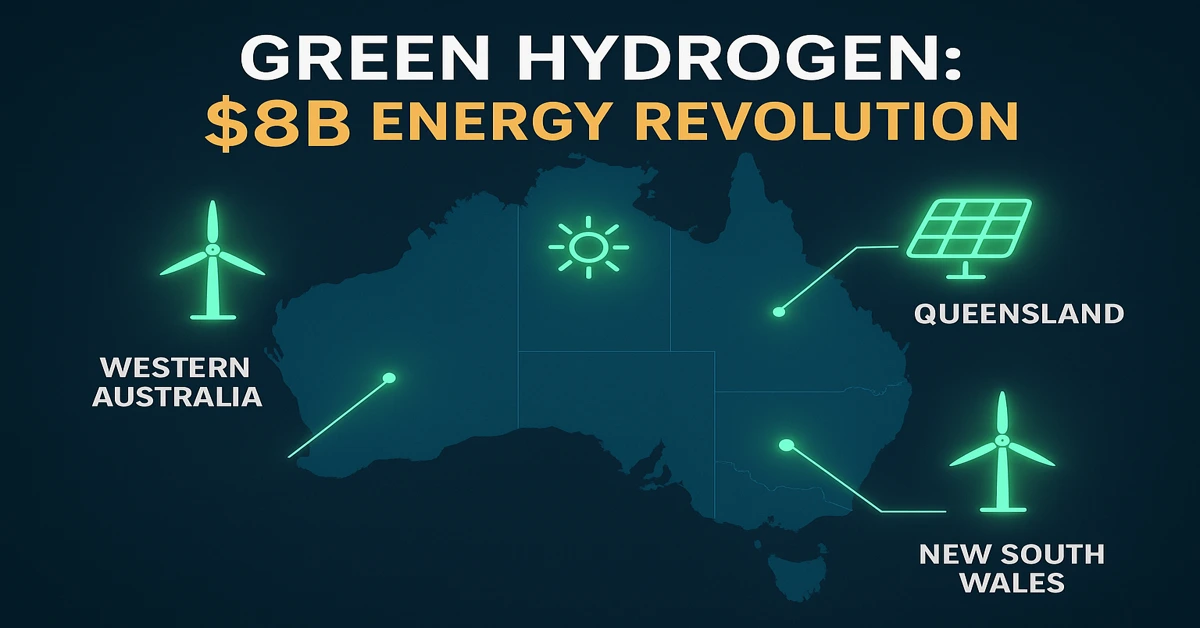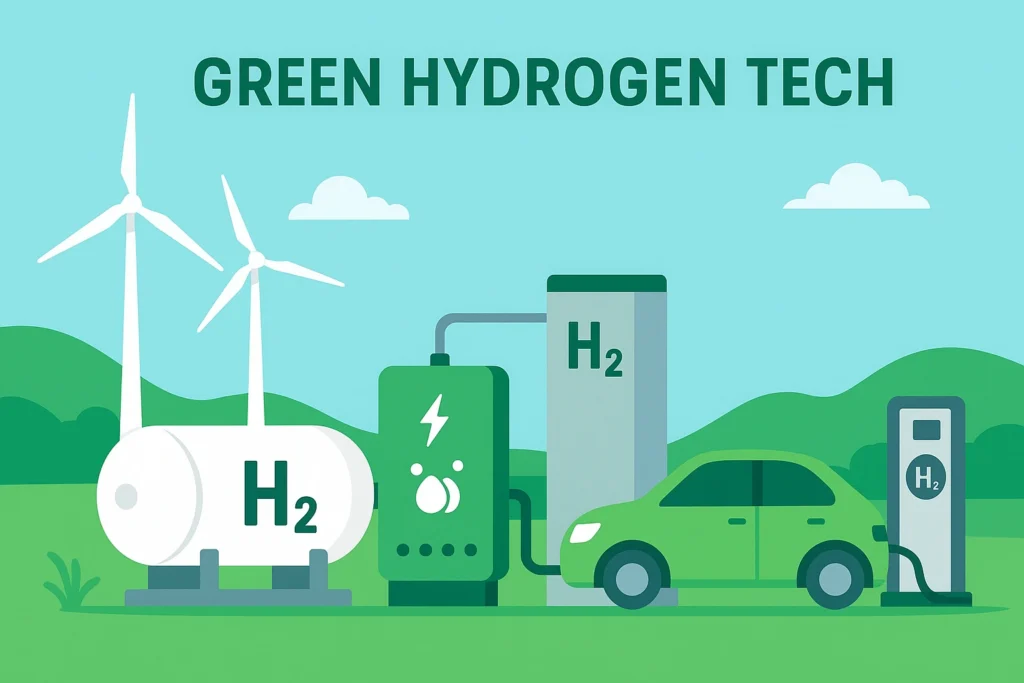Green Hydrogen Tech: Australia’s Next Big Energy Revolution

Australia is entering a new energy revolution worth billions. With an AUD 8 billion government plan, huge renewable resources in Western Australia, Queensland, and New South Wales, and more than 84 GW of electrolyser capacity in the pipeline, the country is fast-tracking its role as a global leader in green hydrogen technology.
In 2024, Australia’s green hydrogen market was valued at USD 47.23 million. By 2033, it is forecasted to surge to USD 2.44 billion, growing at an impressive 48.4% CAGR. Backed by flagship projects, tax incentives, and global partnerships, Australia is building a hydrogen economy that could rival its coal and gas exports.
So, how exactly is Australia shaping the future of hydrogen? Let’s explore.
🌍 What is Green Hydrogen and Why It Matters

Green hydrogen is made by splitting water into hydrogen and oxygen using renewable energy (solar and wind). Unlike grey hydrogen (from fossil fuels) and blue hydrogen (gas with carbon capture), green hydrogen is 100% clean and sustainable.
It plays a vital role in decarbonising sectors that are otherwise hard to clean up, like steelmaking, ammonia production, heavy transport, and power generation.
| Hydrogen Type | Source | Emissions | Cost |
| Grey Hydrogen | Coal/Gas | High 🚫 | Cheap |
| Blue Hydrogen | Gas + CCS | Medium ⚠️ | Moderate |
| Green Hydrogen | Renewables | Zero 🌱 | Higher (falling fast) |
Why Australia is Leading the Hydrogen Race
Few countries are as well-positioned as Australia to dominate hydrogen energy:
- Massive renewable energy resources in WA, QLD, and NSW.
- Strategic export markets: Japan, South Korea, and Europe.
- Strong government policy support and global investment.
The government’s goal:
- 1 million tonnes annual production capacity by 2030.
- 15 million tonnes annually by 2050.
💰 Government Investments & Policies (2025 Update)
Australia’s hydrogen growth is being shaped by game-changing policies and funding:
- AUD 8 billion investment (2024–2034) to scale hydrogen production and technology.
- National Hydrogen Strategy 2024 → Aiming for cost-competitive hydrogen and international leadership.
- Hydrogen Production Tax Incentive (HPTI) → Refundable offset of AUD 2/kg of hydrogen (2027–2040), costing AUD 6.7 billion.
- Hydrogen Headstart Program (AUD 2 billion) → Backing large-scale projects with production credits.
- ARENA funding (AUD 3+ billion) → Supporting hydrogen, green metals, and clean fuels.
- AUD 432 million Hunter Valley Hydrogen Hub (NSW) → Reducing industrial emissions and boosting exports.
These policies are designed to cut emissions, create jobs, and drive exports, especially in industries like ammonia, steel, and transport.
⚡ Major Hydrogen Projects Across Australia
1. Murchison Green Hydrogen Project (WA)
- 6 GW green hydrogen plant beginning in 2027.
- Powered by solar + wind.
- Produces 1.9 million tonnes of green ammonia annually.
- Secured AUD 814 million funding.
2. Orica Hunter Valley Hydrogen Hub (NSW)
- AUD 432 million investment.
- Focused on decarbonising ammonia & explosives production.
- Key export project for Asia.
3. Hydrogen Park South Australia (SA)
- 1.25 MW PEM electrolyser producing 175 tonnes per year.
- Supplies 5% green hydrogen blend into gas networks.
- Cuts CO₂ emissions for households and businesses.
📊 National Pipeline:
- 11 million tonnes annual pipeline capacity.
- 84 GW electrolyser capacity (≈10% of global planned low-carbon hydrogen).
✅ Benefits of Green Hydrogen for Australia
- Economic Growth → Market expected to reach USD 2.44 billion by 2033.
- Job Creation → Tens of thousands of new jobs in energy and infrastructure.
- Energy Security → Less reliance on coal and gas.
- Exports → Strong trade opportunities with Asia & Europe.
- Climate Action → Net-zero pathway for hard-to-abate sectors.
🚧 Challenges to Overcome
While Australia is leading, there are hurdles:
- High production costs (though falling with tax breaks & tech advances).
- Infrastructure gaps (pipelines, storage, export terminals).
- Global competition (Middle East, EU, US also scaling fast).
Still, with supportive policies, private investment, and growing demand, these barriers are being reduced.
🔮 Future Outlook: Will Australia Be the Hydrogen Superpower?
By 2030, Australia aims to:
- Produce over 1 million tonnes annually.
- Operate nearly 50 GW of electrolyser capacity.
- Build a multi-billion-dollar hydrogen export market.
By 2050, the goal is at least 15 million tonnes annually, cementing Australia’s place as a hydrogen superpower and clean energy hub.
📝 Conclusion
Green hydrogen is not just another energy source for Australia, it’s the foundation of a new clean economy. With AUD 8 billion government funding, 84 GW of electrolyser projects, and global trade demand, Australia is on track to lead the hydrogen energy revolution.
FAQs
1. What is green hydrogen?
Hydrogen made from renewables like solar and wind, with zero emissions.
2. Why is Australia investing so heavily?
To reduce emissions, create jobs, and become a global energy exporter.
3. How much is being invested?
Over AUD 8 billion, plus billions more in private partnerships.
4. What are the biggest projects?
Murchison (WA), Hunter Valley Hub (NSW), and Hydrogen Park SA.
5. Will hydrogen replace fossil fuels in Australia?
Not immediately, but it’s expected to replace coal and gas in industries like steel, ammonia, and heavy transport.

Similar Posts
How Can the Velocity Banking Calculator Transform Your Financial Strategy?
Practical Study Tips for High School Students Using AI
Is Coomersu Worth the Hype in 2025? Read This Before You Buy